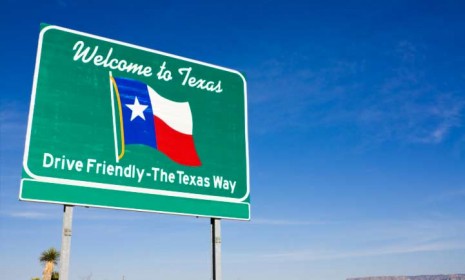What would happen if Texas actually seceded?
Secession fever has struck much of red America after President Obama's re-election. And that's got a lot of people asking "what if...?"


"Talk of secession is in the air," says Brett Arends at MarketWatch. At least a small number of people in each of the 50 states have filed petitions on the White House website "We The People" asking that their state be allowed to leave the Union. Under rules laid out by President Obama, any petition that gets 25,000 "signatures" in 30 days earns an official response: At least seven states have more than 30,000 signatures, and the Texas petition had more than 117,000 as of Nov. 26. All of this secession fever "comes 150 years after the Civil War, and just in time for Steve Spielberg's biopic of Abraham Lincoln, the man whom we have to thank — if that’s the word I want — for the continued forcible marriage of the once-independent states." Of course, nobody really expects any state to openly revolt and agitate for independence, but what would happen if they did? Here's what you should know:
First off: Do states have the right to secede?
No. Like "nullification" — the idea that states can unilaterally ignore a federal law they don't like — secession "is one of those extra-legal concepts that was hotly debated during the decades leading up to the Civil War," says Richard Dunham in the Houston Chronicle. Nullification and secession threats have popped up in the 150 years since, but the question was mostly settled at the Battle of Appomattox Court House. "The bottom line is that any state — or confederation of states — can illegally secede from the Union. But the result, as we discovered in 1861, is Civil War."
The Week
Escape your echo chamber. Get the facts behind the news, plus analysis from multiple perspectives.

Sign up for The Week's Free Newsletters
From our morning news briefing to a weekly Good News Newsletter, get the best of The Week delivered directly to your inbox.
From our morning news briefing to a weekly Good News Newsletter, get the best of The Week delivered directly to your inbox.
Are there any exceptions?
No — although lots of Texans believe their state has a special "opt-out" clause (31 percent, according to a 2009 Rasmussen poll). Part of that may be due to Gov. Rick Perry (R), who told a crowd that year that when the former Republic of Texas "came in the Union in 1845, one of the issues was that we would be able to leave, if we decided to do that." But he was wrong, says Jeff Turrentine at Slate. "Texas' so-called 'right' to secede is no more than a politically emboldening myth, the boastful residue of the decade it spent as a sovereign nation before joining America." Still, the Lone Star State does have "an unusual ace up its sleeve" — its annexation papers do allow Texas to unilaterally split in to as many as five states. Some Texas Republicans posit that faced with the threat of eight new Republicans tilting the balance of the Senate, Washington would let the Texas offshoots leave without a fight.
What would happen if the feds let states go peacefully?
First of all, "it would be excellent financial news for those of us left behind if Obama were to grant a number of the rebel states their wish," says Dana Milbank at The Washington Post. That's because most states threatening to secede are part of the old Confederacy, and "low tax" southern red states typically get "far more from the federal government in expenditures than they pay in taxes." Each California and New Jersey taxpayer, for example, pays thousands each year to subsidize residents of Louisiana and Alabama — the lone exception is Texas, which, thanks to oil revenue, comes out about even, tax-wise.
A free daily email with the biggest news stories of the day – and the best features from TheWeek.com
And what about residents of unshackled red states?
If you're in a state intent on bolting the Union, there is good tax news, says MarketWatch's Arends: "You will be liberated from the sheer living hell of the federal tax code." Of course, you'll also "get fewer government services." Also, your newly independent nation "will go into recession, and fast." The feds would take back their highway, airport, and university research funding, and maybe even demand a refund, says the Fort Worth Star-Telegram in an editorial. Obama would close down or repossess federal courthouses, prisons, national parks, and military bases that pump tens of billions each into local economies. Plus, Texas and other newly minted nations would have to pay for their own militaries, says Jack Simmons at the UT-Arlington Shorthorn. "We would also need some form of health care, some sort of disaster relief, a postal service, welfare, social security, FDA, CIA, FBI — the list goes on," totaling well over a trillion dollars. "And that's just start-up costs."
So why is secession so popular?
It's not, really. Even in Texas, the hotbed of the secession movement, support for breaking free is limited to "a loud but small minority," says the Houston Chronicle's Dunham. Rasmussen clocked it at 18 percent. In other words, "more Texans believe in UFOs than in secession." Mostly, secession talk is just a silly way to register disappointment in the election results, says Glenn Harlan Reynolds at USA Today. Remember "in 2004, when disappointed Democrats were talking about secession, and circulating maps of America divided into 'The United States of Canada' and 'Jesusland'"? But there are serious reasons, too: Some states "feel that the central government doesn't respect them, forces them to live under laws they find repugnant, and takes their money away to pay off its own supporters." The way to fix that is giving states more power — in other words, returning to the federalism the U.S. was founded under. "It's a nice plan. Beats secession."
Sources: Ft. Worth Star-Telegram, Houston Chronicle, MarketWatch, New York Times, Shorthorn, Slate (2), Washington Post, White House, USA Today
Peter has worked as a news and culture writer and editor at The Week since the site's launch in 2008. He covers politics, world affairs, religion and cultural currents. His journalism career began as a copy editor at a financial newswire and has included editorial positions at The New York Times Magazine, Facts on File, and Oregon State University.
-
 How to make the most of chestnuts
How to make the most of chestnutsThe Week Recommends These versatile nuts have way more to offer than Nat King Cole ever let on
-
 Deaths for children under 5 have gone up for the first time this century
Deaths for children under 5 have gone up for the first time this centuryUnder the radar Poor funding is the culprit
-
 Codeword: December 22, 2025
Codeword: December 22, 2025The daily codeword puzzle from The Week
-
 Has Zohran Mamdani shown the Democrats how to win again?
Has Zohran Mamdani shown the Democrats how to win again?Today’s Big Question New York City mayoral election touted as victory for left-wing populists but moderate centrist wins elsewhere present more complex path for Democratic Party
-
 Millions turn out for anti-Trump ‘No Kings’ rallies
Millions turn out for anti-Trump ‘No Kings’ ralliesSpeed Read An estimated 7 million people participated, 2 million more than at the first ‘No Kings’ protest in June
-
 Ghislaine Maxwell: angling for a Trump pardon
Ghislaine Maxwell: angling for a Trump pardonTalking Point Convicted sex trafficker's testimony could shed new light on president's links to Jeffrey Epstein
-
 The last words and final moments of 40 presidents
The last words and final moments of 40 presidentsThe Explainer Some are eloquent quotes worthy of the holders of the highest office in the nation, and others... aren't
-
 The JFK files: the truth at last?
The JFK files: the truth at last?In The Spotlight More than 64,000 previously classified documents relating the 1963 assassination of John F. Kennedy have been released by the Trump administration
-
 'Seriously, not literally': how should the world take Donald Trump?
'Seriously, not literally': how should the world take Donald Trump?Today's big question White House rhetoric and reality look likely to become increasingly blurred
-
 Will Trump's 'madman' strategy pay off?
Will Trump's 'madman' strategy pay off?Today's Big Question Incoming US president likes to seem unpredictable but, this time round, world leaders could be wise to his playbook
-
 Democrats vs. Republicans: who are US billionaires backing?
Democrats vs. Republicans: who are US billionaires backing?The Explainer Younger tech titans join 'boys' club throwing money and support' behind President Trump, while older plutocrats quietly rebuke new administration
